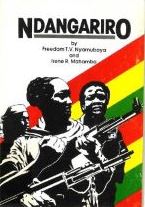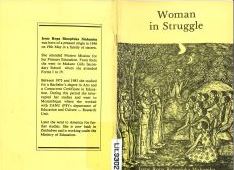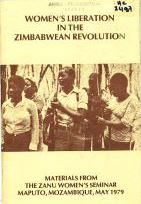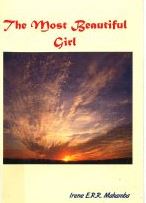Irene Ropa Rinopfuka Mahamba: a woman’s take on the Zimbabwe Chimurenga
 The Zimbabwean nationalist newspaper The Patriot often provides an interesting assessment of published authors writing about all things Zimbabwean. As of its maiden issue in 2011 it regularly reviews new and old books on the liberation struggle (Chimurenga) against the Ian Smith regime and accounts by former Rhodesians. In one of their issues in December 2015 the editor looks back and summarises the literary harvest with an essay “2015 book reviews: Rhodies hijack struggle narrative”. According to him a positive exception in this paradigm is Irene Mahamba (1956-). Her book Ndangariro was reviewed in July 2015 (“A glimpse into the psyche of a female veteran”).
The Zimbabwean nationalist newspaper The Patriot often provides an interesting assessment of published authors writing about all things Zimbabwean. As of its maiden issue in 2011 it regularly reviews new and old books on the liberation struggle (Chimurenga) against the Ian Smith regime and accounts by former Rhodesians. In one of their issues in December 2015 the editor looks back and summarises the literary harvest with an essay “2015 book reviews: Rhodies hijack struggle narrative”. According to him a positive exception in this paradigm is Irene Mahamba (1956-). Her book Ndangariro was reviewed in July 2015 (“A glimpse into the psyche of a female veteran”).
Chimurenga: true perspective of a female veteran
Mahamba’s name is occasionally mentioned in The Patriot by her colleagues (Mahamba contributes to the paper under the name Ireen), and she is often the only woman in the overwhelmingly male authorship. According to the writer Shingirai Mutonho, she stands out as one of the local writers representing a true, Zimbabwean perspective on the liberation struggles. He praises her work together with male authors such as Charles Mungoshi, Alexander Kanengoni, Aaron Moyo and Cosmas Nyamutswa. All of these accounts are contrasted to the books by “Rhodies” such as Paul Moorcraft ("The Rhodesian War"), Chris Cocks (“Fireforce : one man's war in the Rhodesian Light Infantry” and Paul Mclaughin ("Rhodesian war: a military history”) , whose works are “downplaying the role played by locals during the liberation struggle.”
Women in the liberation wars
 Books and articles by Zimbabweans on the women in the liberation wars certainly are not absent; actually for Zimbabwe they get a fairer share than in most other conflicts (at least beyond their role as victims). “When ZANU was formed in August 1963, it recognized clearly the fundamental role of the woman as an activist alongside her male counterpart in the Party. That is why provision was made in our Constitution for the creation of the ZANU WOMEN’S LEAGUE” ((Women's liberation in the Zimbabwean revolution : materials from the ZANU Women's seminar, Maputo, Mozambique, May 1979, p. 16). However, based on a far from representative sample in our catalogue, the narratives, poems, reports and books written by these women activists are seldom published by the prestigious publishing houses. For example “Health impact of participation in the liberation struggle of Zimbabwe by ZANLA women ex-combatants in the ZANLA operational areas” by Manyame-Tazarurwa was self published at AuthorHouse.
Books and articles by Zimbabweans on the women in the liberation wars certainly are not absent; actually for Zimbabwe they get a fairer share than in most other conflicts (at least beyond their role as victims). “When ZANU was formed in August 1963, it recognized clearly the fundamental role of the woman as an activist alongside her male counterpart in the Party. That is why provision was made in our Constitution for the creation of the ZANU WOMEN’S LEAGUE” ((Women's liberation in the Zimbabwean revolution : materials from the ZANU Women's seminar, Maputo, Mozambique, May 1979, p. 16). However, based on a far from representative sample in our catalogue, the narratives, poems, reports and books written by these women activists are seldom published by the prestigious publishing houses. For example “Health impact of participation in the liberation struggle of Zimbabwe by ZANLA women ex-combatants in the ZANLA operational areas” by Manyame-Tazarurwa was self published at AuthorHouse.
Self-published
Mahamba is no exception. Although her first book Woman in Struggle (1984) was published by the Mambo Press, an important player in the printing industry, her other three titles never made it into the major publishing houses’ catalogues. With financial help of the International Women’s Development Agency the NGO Zimbabwe Foundation for Education with Production (ZIMFEP) published her story Ndangariro. This might partly be attributed to the fame of her better known co-author Freedom Tichaona.V. Nyamubaya (died 2015 https://wikiz.com/wiki/Freedom_Nyamubaya ) who contributed 12 poems to the book (but was mentioned as the first author on the cover!).
The final two titles by Irene Mahamba seem to be produced by a copyshop and were personally sold (and autographed!) by the author in August 2012, at the Harare International Book Fair. The most beautiful girl is a novel about a 34 year old single mother of two who discovers she is HIV positive. Although most of the book is written in English, the amount of dialogues and idiom in Shona betray the intended target audience as Zimbabwean. This is also the case with the autobiographical Comrade mother, a moving memoir in honour of the author’s mother.
Gerard C. van de Bruinhorst

